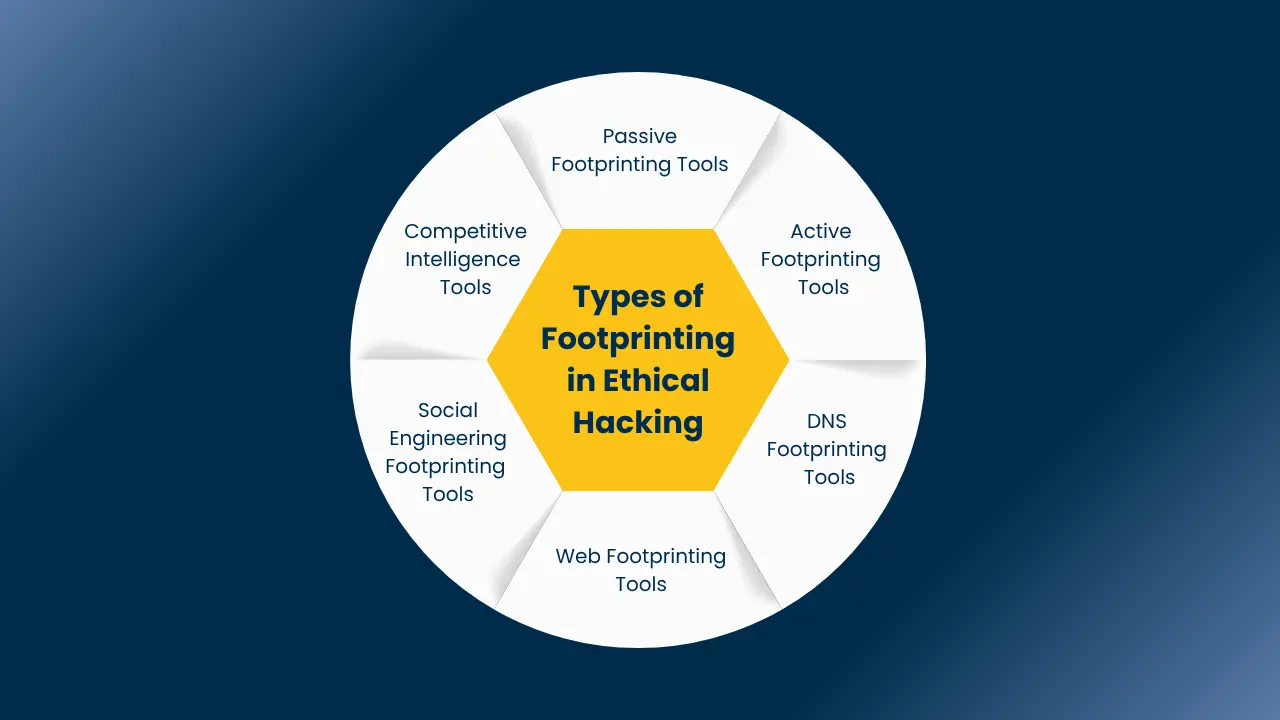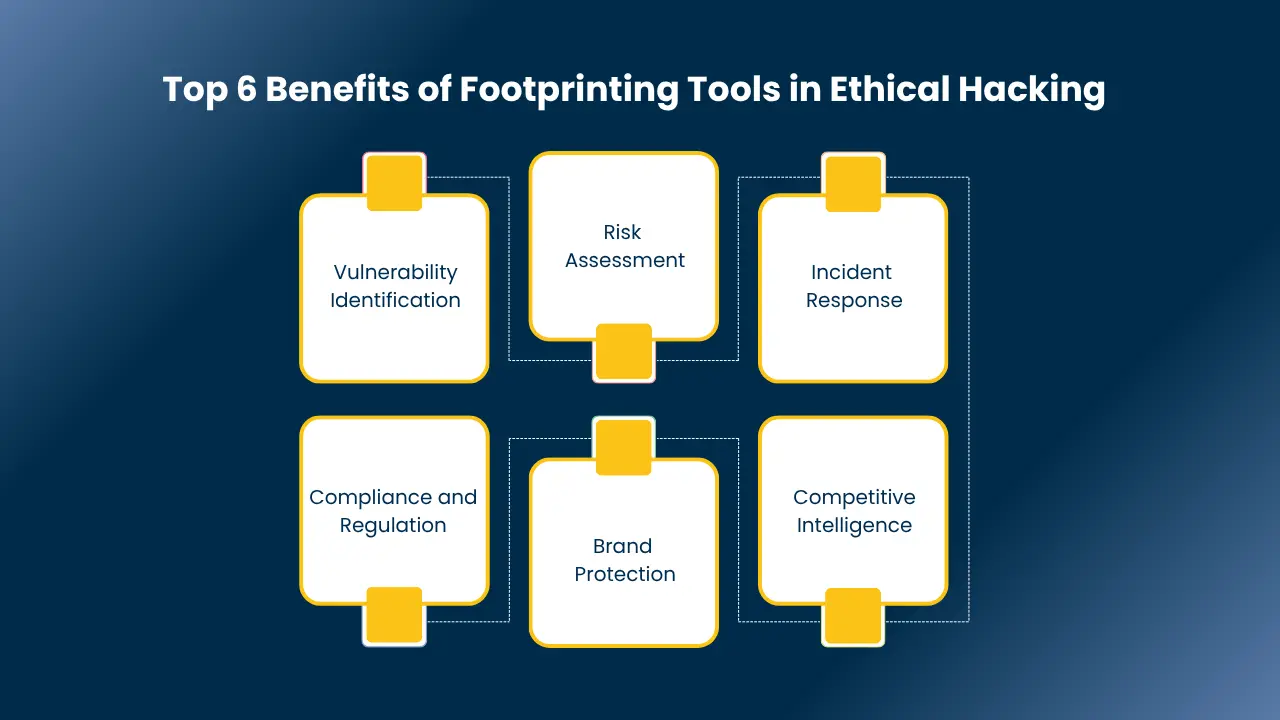What is Footprinting in Ethical Hacking? Which Tool is Best for You?

In ethical hacking, the beginning of learning about a target system is to learn as much as can be known about it and footprinting tools in ethical hacking are where this starts. Footprinting tools assist cybersecurity specialists in obtaining important information such as domain information, IP address, network infrastructure, and much more before they ever have direct contact with the system.
At Orbus Cybersec Trainings, we are of the opinion that it is critical to master footprinting tools and techniques for every ethical hacker. Whether you are an entry-level cybersecurity professional or are gearing up for expert-level penetration testing, mastering the proper tools and methods puts you light years ahead. In this blog post, we will discuss what footprinting is, the top footprinting tools list in ethical hacking, and why these tools assist in the discovery of system weaknesses early in the hacking process.
What is Footprinting?
Footprinting is the initial phase of ethical hacking, in which hackers attempt to obtain as much information as possible about the target system, network, or organization without carrying out any attacks. The objective is to get an idea of the target’s online environment, detect vulnerabilities, and determine the security stance prior to testing.
What are the two primary forms of footprinting?
1. Passive Footprinting: Data are gathered without actually contacting the target (e.g., via search engines, WHOIS databases, or public websites).
2. Active Footprinting: Physical contact with the target occurs (e.g., ping sweeps, port scanning, or traceroutes).
This phase sets the foundation for the ethics of hacking. The more precise the footprint, the stronger the penetration test.
What are Footprinting Tools in Ethical Hacking?
Footprinting tools in ethical hacking are programs or frameworks that are used to automate and optimize the process of data collection. The tools are geared towards delving deep into the internet and extracting important information about a target such as IP addresses, domain registration, open services, and online digital footprints left behind.
Some of the popular footprinting techniques tools used in ethical hacking to employ include:
- DNS lookups to determine domain-IP mappings
- WHOIS queries to reveal registration information
- Network scanning to identify open ports and services
- Web scraping to scrape data from websites
- Search engine dorking to identify misconfigurations or leaks
- Social media mining to gather employee or company-specific information
These tools simplify, hasten, and streamline it for ethical hackers to create an in-depth target profile lowering manual labor while improving accuracy.
Types of Footprinting in Ethical Hacking
Footprinting tools in ethical hacking are of different types, each serving a different kind of data collection. Passive observation to active scanning, ethical hackers use these footprinting tools to identify vulnerabilities through different means. The following is a list of categorized footprinting tools in ethical hacking with examples:

1. Passive Footprinting Tools
Passive footprinting tools gather details without detecting the target. They use publicly available information such as search engines, social networking sites, or hacked databases to chart the online environment.
Some examples include:
- Google Hacking Database (GHDB) – Employ search engine queries to reveal exposed information.
- Shodan – Searches the internet for online connected devices and services.
- Recon-ng – An open-source reconnaissance platform for collecting open-source intelligence (OSINT).
2. Active Footprinting Tools
These tools communicate directly with the target system to collect more in-depth information. They employ scanning methods to identify open ports, services, OS versions, and so forth.
Some examples include:
- Nmap – Useful for port scanning and network mapping.
- Nessus – Conducts vulnerability scans.
- OpenVAS – Detects security vulnerabilities in networked systems.
- Nikto – Scans web servers for out-of-date software and misconfigurations.
- QualysGuard – A cloud scanner for network vulnerabilities.
3. DNS Footprinting Tools
DNS tools specialize in collecting data about a target’s domain infrastructure. They expose DNS records, subdomains, and possible misconfigurations.
Some examples include:
- DNSenum – Automates DNS enumeration to discover subdomains, name servers, and IP addresses.
- fierce – Scans domains to find non-contiguous IP space and DNS misconfigurations.
- dnsrecon – Performs standard record enumeration, zone transfers, and brute force subdomain discovery.
4. Web Footprinting Tools
Web footprinting tools collect information from websites and web applications such as server details, software stacks, and exposed directories.
Some examples include:
- theHarvester – Extracts email addresses, subdomains, and others.
- Maltego – Maps relationships between entities on the internet.
- Netcraft – Offers details on hosting providers, server locations, and site history.
- WebShag – Searches websites for vulnerabilities and concealed content.
5. Social Engineering Footprinting Tools
They rely on human activity as a source of information. They extract information from forums, social networks, and online profiles to reveal human-related vulnerabilities.
Some examples include:
- SpiderFoot – Automates OSINT collection, including social media data, breach info, and usernames.
- Creepy – Gathers geolocation and metadata from social media platforms and shared content.
- Maltego – Maps relationships between people, emails, and online identities through deep data correlation.
6. Competitive Intelligence Tools
While not hacking tools per se, they are helpful for business-oriented footprinting. They gather information about competitors, traffic sources, and online performance.
Some examples include:
- SimilarWeb – Analyzes website traffic, visitor demographics, and engagement metrics.
- SEMrush – Tracks competitor keywords, SEO performance, and online advertising data.
- SpyFu – Reveals competitor paid and organic keyword strategies for search marketing.
All these footprinting tools and methods assist the ethical hacker in selecting the correct method according to their intention. Conducting either passive research or deep scans, each of these tools contributes to creating a full picture of the target’s digital footprint.
Also Read: Best Certified Ethical Hacking (CEH) Courses in Madurai – 2025 List
10 Best Footprinting Tools in Ethical Hacking
Selecting the proper tools is crucial to efficient information gathering. The following is a list of footprinting tools in ethical hacking, grouped by functionality and extensively relied on by cybersecurity experts for efficiency, accuracy, and richness of information.
1. Maltego
Maltego is a graph-based OSINT tool designed for mapping relationships between individuals, companies, domains, and IPs. Its robust data integration and live graphing capabilities make it a go-to tool for revealing concealed digital associations.
Best for: Data visualization, relationship mapping, social media and DNS tracking
Category: OSINT Tool / Social Engineering
2. TheHarvester
TheHarvester is a light, command-line program that collects emails, subdomains, and hostnames from search engines, PGP servers, and social networks. It’s quick, easy, and efficient for early-stage passive footprinting.
Best for: Gathering emails, hostnames, and subdomains
Category: OSINT Tool / Passive Recon
3. SpiderFoot
SpiderFoot streamlines the footprinting process by collecting intelligence from more than 100 sources. It scans DNS records, WHOIS information, IPs, exposed credentials, and even dark web references to give an overall security snapshot.
Best for: Automated collection of intelligence from several sources
Category: OSINT / Passive and Active Footprinting
4. Recon-ng
Recon-ng is a modular web reconnaissance framework with a variety of footprinting modules to include DNS lookup, subdomain discovery, social media profiling, and port scanning. It is very customizable and well-suited for structured engagements.
Best for: Modular recon and automation
Category: Web Recon Framework
5. Shodan
Shodan is an Internet-connected device search engine. Although not a typical footprinting tool, it’s incredibly handy for finding exposed services, misconfigured devices, and IoT.
Best for: Searching exposed services and devices
Category: Network Search Engine
6. SuperScan
SuperScan is a port scanning application for Windows that enables users to scan for open services and ports on a target system. It’s particularly handy in the active footprinting phase.
Best for: Service and port scanning
Category: Network Scanning
7. Netifera
Netifera integrates network scanning, monitoring, and visualization. It detects hosts and services and has analytical tools for in-depth network scanning.
Best for: Scanning with network visualization
Category: Network Analysis Tool
8. Sam Spade
Sam Spade does DNS lookups, WHOIS queries, IP tracking, and more within a single interface. It’s flexible and excellent for determining how a target is connected over the internet.
Best for: Network diagnostics and DNS queries
Category: Network & Connectivity Tool
9. TcpView
TcpView gives real-time information on active TCP and UDP connections. It enables users to see what processes are talking across the network and is handy in identifying malicious or unauthorized connections.
Best for: Live network connection monitoring
Category: Network Monitoring
10. FOCA (Fingerprinting Organizations with Collected Archives)
FOCA examines metadata from files such as PDFs and Microsoft Office documents. It can extract usernames, program versions, and server paths usually giving away sensitive internal information.
Best for: Metadata retrieval and document analysis
Category: Document & Metadata Footprinting
Read More: 50 Ethical Hacking Interview Questions and Answers You Must Know
Top 6 Benefits of Footprinting Tools in Ethical Hacking
Applying footprinting tools in ethical hacking provides a number of strategic benefits to both cybersecurity experts and organizations. These tools are more than simple data gathering they have an essential role in enhancing security, evaluating threats, and sustaining a competitive advantage.

1. Vulnerability Identification
Footprinting applications assist in the identification of probable vulnerabilities in a system’s infrastructure. Analysis of information from sources such as DNS records, WHOIS data, open ports, and websites by footprinting applications reveals areas of susceptibility to attack. Detection of such vulnerabilities at an early stage enables organizations to implement proactive security measures like patching, access control, or segmentation.
2. Risk Assessment
Precise footprinting methods give a complete picture of an organization’s digital footprint. With in-depth information on domain setup, IP blocks, network topology, and internet usage, security teams can better evaluate potential risks. This assists in prioritizing vulnerabilities according to severity and deploying resources where they can do the most good.
3. Incident Response
During a breach, footprinting tools facilitate rapid investigation and containment. By tracing impacted systems and determining potential entry points, these tools help incident response teams gain insight into the extent of compromise. The sooner detection occurs, the sooner recovery reduces damage and shortens downtime.
4. Competitive Intelligence
Certain footprinting tools and techniques can be employed in market analysis. Companies can collect publicly available information on competitors such as website architectures, social presence, and technology infrastructures to understand strategies, positioning, and customer interaction. This information can aid decision-making for marketing, product planning, and pricing policy.
5. Brand Protection
Keeping your brand’s reputation online is of utmost importance. Footprinting tools assist in tracking brand mentions in forums, social media, and websites. Monitoring conversations and possible abuse of brand assets enables organizations to act promptly to counteract negative publicity, secure intellectual property, and maintain customer trust.
6. Compliance and Regulation
With increasing regulatory requirements, organizations need to make sure their digital practices are compliant. Footprinting tools help uncover unauthorized exposure of sensitive information, misconfigured services, or shadow IT processes. This helps companies impose correct controls and prove compliance with regulations such as GDPR, HIPAA, or ISO requirements.
Conclusion
Proficiency in footprinting tools in ethical hacking is a core skill for every cybersecurity expert. These tools allow ethical hackers to collect extensive details of target systems, detect vulnerabilities, and measure risks before initiating any attack simulation. From passive reconnaissance to active scanning, the selection of appropriate footprinting techniques and tools makes the penetration test more effective and focused. At Orbus Cybersec Trainings, we arm students with practical skills in the utilization of the most effective footprinting tools and methods to enable them to establish a solid foundation in ethical hacking and move ahead in their cybersecurity careers confidently.
Understand how Orbus can help your career!
Speak with an Expert Now!
FAQ's
What are the tools used for footprinting?
Footprinting software in ethical hacking encompasses a broad set of programs used to collect information regarding a target system. Some popular tools are Maltego for graphical mapping, TheHarvester for email and subdomain collection, SpiderFoot for OSINT collection on auto-pilot, Recon-ng for modular reconnaissance, and Shodan for finding internet-facing devices. These solutions identify weaknesses, exposed ports, DNS records, WHOIS information, and many other things all necessary for a successful penetration test.
What is footprinting in ethical hacking?
Footprinting in ethical hacking refers to the starting step of reconnaissance in which data is gathered regarding a target system, network, or organization. This encompasses information such as domain names, IP addresses, server settings, and employee information. The aim is to create an extensive digital outline of the target without triggering any alarms, which assists ethical hackers in evaluating possible vulnerabilities prior to initiating any attacks.
Which is the ethical hacker tool?
There isn't one; they have a mix of tools based on the stage and objective. Footprinting uses TheHarvester, Maltego, Nmap, SpiderFoot, and Recon-ng to name a few. Each has different areas like DNS enumeration, social media scraping, port scanning, and metadata fetching. The best footprinting tools in ethical hacking ensure complete and efficient data collection.
What are the five stages of ethical hacking?
Five stages of ethical hacking are:
Reconnaissance (Footprinting): Collecting information for the first time with footprinting tools and processes.
- Scanning: Discovering open ports, services, and weaknesses.
- Gaining Access: Making use of weaknesses to gain control.
- Maintaining Access: Creating a permanent presence on the system.
- Covering Tracks: Erasing logs and concealing intrusion activity in order to go unnoticed.
Each of these phases is vital in order to effectively mimic actual cyberattacks and enhance security defenses.




